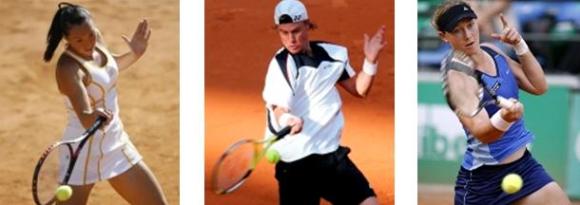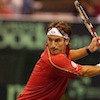The Origin Of Forehand And Backhand Tennis Technique
You can develop tennis technique in a very simple and natural way. Have you ever asked yourself: Why do all these 3 forehands look very similar?

|
Just to clarify, by tennis technique I refer to certain position and movement of legs and arms which are supposed to be correct - for example:
- when you are prepared for the shot on groundstrokes, the butt of the racquet is pointed towards the ball
- at the point of contact the racquet is parallel to the ground and the arm is bent in the elbow
- the follow through for forehand is above your shoulder
- closed stance means that legs are one after another, open stance means they are parallel
- for one handed backhand the body needs to remain sideways when you are hitting the ball
- ...
But why has to be technique more or less like this?
Is there a simpler way, a more natural and much quicker way of learning tennis than memorizing tens of little instruction tips?
Yes, there is and for that we need to understand why is technique like that.
There are 3 main factors that define the tennis technique.
For the sake of simplicity and easier understanding lets focus first on forehand and backhand and later apply these principles to volleys and serve.
The first factor is the law of physics which includes geometry, gravity, air resistance and other.
Your goal in tennis is to make the ball fly above the net and then land inside the court.
Developing Tennis Technique Step 1: Angles
In order for a player to control the ball flight they need to control direction (left - right) and depth / distance which is closely related to height of the shot.This means that the player controls the ball with the angle of the racquet with which he directs the ball left or right and up or down. He also controls the ball with the force / speed with which he hits the ball and with the angle of the path of the racquet.
The racquet face may move towards the ball in a straight line or with an angle - for example the racquet may be moving upwards when contacting the ball.
So in a very simple way of saying, we have a flat surface with which we direct the ball towards the target. We can control the left - right angle and the top - bottom angle and how much force / speed we use to hit the ball.
Developing Tennis Technique Step 2: Swing
We can also move the racquet at a certain angle towards the ball. Of course as you can see from the video, holding the racquet in this way does not give us enough power so need a way of accelerating the racquet more.That's the second factor and it's the biomechanics of our body. We need to hold the racquet in the hand and swing on the side of the body. That way we can produce a lot of speed and transfer the energy from the racquet.
Developing Tennis Technique Step 3: Drive Through The Ball
The third factor that determines tennis technique is the limited ability of the human mind and body.If we swing towards the ball with a racquet in our hand, we will move the racquet in a circular way since the arm acts as a lever attached to the body.
If we had a perfect computer in our mind and perfect judgment of speed and distance of the ball, then this technique would work great. It would give us the maximum speed of the racquet face.
But we don't.
To give you some idea about the difficulty of hitting the ball at the right angle to direct it towards our desired target, here are some numbers:
If you change the angle of the racquet by 1 degree (left - right), you will change the landing spot on the distance of the tennis court by 40 centimeters.
If you rally with a friend at a slow speed, the ball may be coming towards you with the speed of 40 km per hour. A typical swing speed towards the ball with your racquet is about the same.
For the sake of easier calculations let's say that the combined speed of the ball coming to you and your racquet going towards the ball is 72 km / hour or 20 meters per second.
That means that the ball travels 1 meter in 0.05 seconds. If your arm and racquet together are 150 cm long, then when you move your racquet forward for one inch (2,5 cm), you will change the racquet angle for 1 degree.
The ball travels one inch - 2,5 centimeters in 0,00125 seconds.
So if you don't wan't to miss more than 80 centimeters (40cm left or 40 cm right), you must hit the ball within 3 thousands of a second of the perfect timing!

|
Picture: Note how different points of contact determine where the racquet face is pointing if we just swing the racquet around our body.
This makes you wonder how we are actually able to play tennis.
Since this is impossible for a human brain and body to calculate every time perfectly, we can compensate with our body and especially the arm since it is not straight like a stick, but it can bend.
What we want to achieve is to move the racquet face pointing towards the target in a straight line, so that even if we mistime the ball for a few thousands of a second, it will still go in the right direction.
With this we effectively compensate for our imperfect ability to judge the ball speed, distance and swing at the right time.
So the racquet needs to move like this:
SIDEBAR
Another benefit of this movement is that we feel we have more control of the ball. The ball actually starts going where we imagined it to go.
A very good trick to understand the effect of a long "push" through the ball in to actually have someone push you for a short time and for a longer time and your goal is to know exactly in which direction they pushed you.
The ball "understands" the racquet in a very similar way. If it is contacted and "pushed" towards a target only for a short time, it doesn't get enough information to know where exactly needs to go.
So it will fly "somewhere" there.
If the ball is contacted for a longer time, it will know much better where to go. ;)
SIDEBAR
Developing Tennis Technique Step 4: Top Spin
The last component of correct tennis technique is spin and that's again the first factor - the law of physics.Spin enables you to hit the ball fast and it will still land inside the court because of the air pressure which is higher above the ball than under the ball.
For more detailed explanation of this phenomenon check this article.

|
| Picture from NASA Moon tennis |
In order to spin the ball the racquet needs to brush the ball going from under and upwards.
That way the ball will spin forward and this will make it curve down sooner.
You need to combine the previous motion of moving the racquet forward in a straight line with moving the racquet upwards and creating spin.
See if you can notice this element of tennis technique in these pictures of Tommy Haas' forehand. Notice the racquet keeping the same angle and moving upwards.

|
| Pictures from Hi-techtennis.com |
Developing Tennis Technique Step 5: Putting It All Together
And what is the last step? The last step is finding the most energy efficient, economical, comfortable way of doing this.This includes the grip, body position, footwork and transferring your movement into the ball in a controlled way.
A good way to find these elements of tennis technique is to go to extremes. Let's first find the best grip; watch the two videos to see how I experiment with both extremes and how uncomfortable and non-economical that is.
So what grip is the most comfortable and gives me the most control and power so that I can drive my racquet forward in a straight line and at the same time move it upwards with good acceleration?
That's eastern forehand grip or semi-western for a little more natural spin on the forehand side and eastern backhand grip on the backhand side. But the names of the grips are totally irrelevant unless you want to compete in a quiz. ;)
How about the footwork? Surely you've heard about the closed and open stance and the stances in between.
Again, go to extremes and find the position of your feet that give you the most power, comfort and control.
In case of forehand you'll notice that open stance feels the strongest while closed stance enables to drive the racquet forward in straight line longer and thus gives you more precision.
Backhand usually feels best only in closed stance but open stance is often needed in extreme situations.
That's how you learn the footwork - by feeling it. And now what you need to do is get into this position before you hit the ball.
Now just hit hundreds of balls trying to achieve:
- keep the racquet face pointing towards the target for a while
- move the racquet from below upwards to impart spin
THAT'S IT!
Instead of trying to hit the ball with correct tennis technique which may be :
- grip like this
- elbow bent
- follow through above your shoulder
- stay sideways
- drive through and keep the racquet pointing towards the target
- move the racquet upwards
You may also like -








